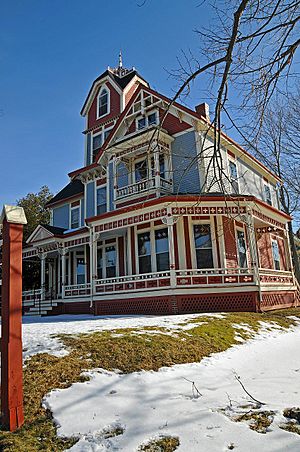Shand House Museum facts for kids

Shand House Museum
|
|
| Established | 1948 |
|---|---|
| Location | 389 Avon Street Windsor, Nova Scotia, Canada |
| Type | Heritage Building |
The Shand House Museum is a special place in Windsor, Nova Scotia. It is part of the Nova Scotia Museum and shows what life was like over 130 years ago. This beautiful house was built in 1890-1891 for Clifford and Henrie Shand. It is a great example of the Queen Anne Revival style, popular in the late Victorian era.
Inside, you can see many of the original family items. These include furniture, dishes, artwork, toys, photos, and books. Many pieces of furniture were made right in Windsor at the local Furniture Factory. The house was also very modern for its time. It had indoor plumbing, central heating, and even electric lights soon after it was finished!
Contents
Who Lived in Shand House?
The Shand House was home to only four people. These were Clifford and Henrie Shand, and their two children, Errol and Gwendolyn.
Clifford Shand: Bicycle Enthusiast
Clifford Shand was a local businessman. He was also very keen on bicycles, which was a big trend in the 1890s. His father, Andrew P. Shand, helped own the Windsor Furniture Factory. Workers from this factory made much of the furniture and fancy decorations inside the house. You can still see many photos and trophies in the house that show Clifford's cycling adventures.
Henrie Shand: An Artist
Clifford's wife, Henrie, was an artist. Many of her paintings are still displayed throughout the home. They add a personal touch to the museum.
Gwendolyn Shand's Gift
Gwendolyn V. Shand, Clifford and Henrie's daughter, lived in the house for many years. She later gave the house to the Nova Scotia Museum. The Shand House Museum officially opened its doors in 1985.
Why is Shand House Important?
The Shand House is not just a memorial to the Shand family. It is kept as a well-preserved example of history. It shows us what architecture, economy, and social life were like in Nova Scotia in the 1890s. It helps us understand how people lived and what was important to them during that time.
In 2019, the museum was open for visits by appointment.

